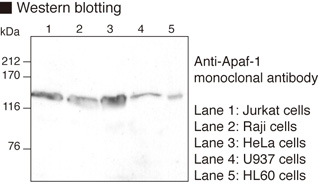Anti-Apaf-1 (Human) mAb
| Code | Size | Price |
|---|
| MBL-M074-3 | 100 ug | £280.00 |
Quantity:
Prices exclude any Taxes / VAT
Overview
Host Type: Mouse
Antibody Isotype: IgG1
Antibody Clonality: Monoclonal
Antibody Clone: 5C1
Regulatory Status: RUO
Target Species:
- Human
- Mouse
- Rat
Application: Western Blot (WB)
Shipping:
4°C
Storage:
-20°C
Images
Documents
Further Information
Applications:
WB - 5 ug/mL
Background:
Apoptosis occurs during normal cellular development and involves dramatic changes in cellular structure. Disruption of apoptosis may contribute to cancer as well as other autoimmune diseases. Recently,
the mammalian homologue of the key cell death gene CED-4 in C. elegans has been identified from human and mouse, and designated Apaf-1 (apoptosis protease activating factor 1) (Ref. 1,2). Apaf-1 binds to cytochrome c (Apaf-2), a reaction that requires dATP, and this leads to the formation of a large multimeric complex. The complex recruits pro-caspase-9, and activates caspase-9 (Apaf-3). Activated caspase-9 in turn cleaves and activates caspase-3, one of the proteases responsible for the proteolytic cleavage of many key proteins in apoptosis. Apaf-1 is ubiquitously expressed in human tissues (1).
Concentration:
1 mg/mL
Formulation:
Supplied as 100 micrograms of IgG in100 ul volume of PBS containing 50% glycerol.Contains no preservatives.
Gene IDs:
Human: 317 Mouse: 11783 Rat: 78963
Immunogen Translated:
His-fusion protein of human Apaf-1N-terminal region (1-421 aa)
Reactivity:
This antibody detects ~130
kDa of human Apaf-1 protein from whole cell
lysate of human cell lines, such as Jurkat, HeLa
and U937 on Western blotting.
Shelf Life:
1 year
Source:
This antibody was purified from cell culture
supernatant using protein-A Sepharose. This hybridoma
was established by fusion of mouse myeloma P3U1 with
Balb/c splenocyte immunized with His-tagged human
Apaf-1 fusion protein corresponding to N-terminal amino
acids (1-421 a. a.).
Target:
Apaf1
References
1) Pan G. et al., J. Biol. Chem. 237 (10):5841-
5845 (1998)
2) Yoshida, H. et al., Cell 94: 739-750 (1998)
3) Cecconi, F., et al. (1998) Cell 94:727-737.
4) Adrain C. et al., J. Biol. Chem. 274:20855-
20860 (1999)
5) Perkins C. L. et al., Cancer Res. 60:1645-
1653 (2000)




